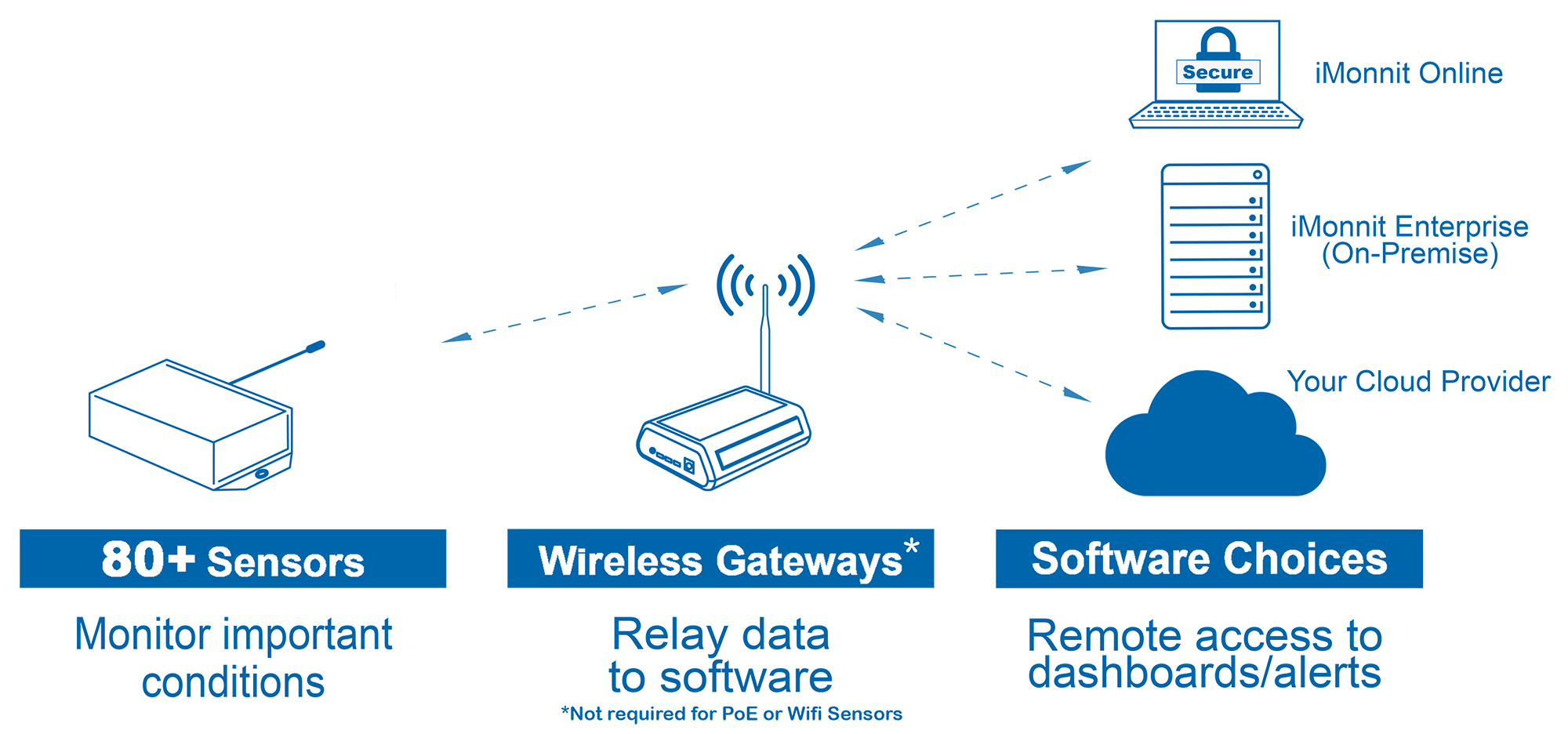-
OVERVIEW
Maintain comfort and proper ventilation
Monnit’s Enterprise Air Velocity/Speed Wireless Sensor helps facility managers and maintenance techs gauge and track HVAC performance by measuring system airflow and building/room pressure.
If air velocity (speed) deviates from user-set limits, an alert is issued instantly via text, email, or call. Early notifications allow HVAC contractors or maintenance techs to prevent failure (or predict and shorten downtime). Collected data also enables facility maintenance professionals to maintain comfort and proper ventilation, as well as track air volume filter status.
This air velocity/speed sensor measures the pressure difference between its two ports, accounts for ambient temperature and altitude, and determines system airflow speed in meters per second (m/s). The sensor is calibrated, temperature compensated, and has a -50 m/s to +50 m/s measurement range.
Run at full speed
The Wireless Air Velocity Sensor measures the pressure difference between two input ports, the temperature, and altitude determines the speed at which the air is moving in a system and transmits the measurement to iMonnit. When viewing the sensor from the top, the right inlet port is the positive or high side pressure input. When the pressure on this port is greater than the left port the sensor produces a negative pressure reading. When the pressure is greater on the left port the sensor produces a positive pressure reading. Combined with the temperature and the altitude, the sensor determines at what rate the air is flowing in a system.
This sensor comes with an industrial battery included with the life of up to 7 years.
All industrial sensors are enclosed in a reliable, weatherproof NEMA-rated enclosure that are constructed for both indoor and outdoor use. These rugged enclosures protect the sensor circuitry against;
- Falling dirt
- Wind-blown dust
- Rain, sleet, snow, splashing water, and hose-directed water
- Ice formation on the enclosure
- Increased resistance to corrosion
Features
- Impressive wireless range of up to 1,200 feet through walls
- Frequency-hopping spread spectrum (FHSS)
- Improved interference immunity
- Improved power management for longer battery life
- Encrypt-RF® Security (Diffie-Hellman Key Exchange + AES-128 CBC for sensor data messages)
- Over-the-air updates
- Free iMonnit basic online wireless sensor monitoring and notification system to configure sensors, view data and set alerts via SMS text and email
- Stores 2000 to 4000 readings if gateway connection is lost (non-volatile flash, persists through the power cycle)
- 10-minute heartbeats = ~ 22 days
- 2-hour heartbeats = ~ 266 days
Applications
- Hospitals
- Duct Pressure
- Building/room Pressure
- Variable air volume filter status
- Air flow
- Computer rooms
-
GATEWAY
Gateway Options for Seamless IoT Data Communication
Monnit offers a range of gateway options designed to facilitate wireless sensor data communication within IoT networks. These gateways, serve as crucial conduits for transmitting sensor data to the iMonnit software platform and play a pivotal role in ensuring seamless and efficient data transmission for IoT applications.
Click here to explore the diverse range of gateway devices available >>
-
SOFTWARE
Manage Your Monnit Sensors with iMonnit Cloud-based Software
Monnit’s Sensor Monitoring Software, iMonnit, stands as a cutting-edge cloud-based platform and central hub tailored for the seamless management of Monnit sensors. With a focus on data security, all information is safeguarded on dedicated servers running Microsoft SQL Server. This intuitive online user interface serves as a command centre for arranging, monitoring, and modifying device settings to suit individual requirements.
OneTemp provides complimentary activation and setup services for new iMonnit accounts, while a free mobile app empowers users to maintain control at all times. Whether opting for the basic version or upgrading to iMonnit Premiere, users can unlock the full spectrum of features that enrich the Monnit experience.
Click here to explore the software options >>
-
SPECIFICATIONS
Supply voltage 2.7-3.8 VDC (3.0-3.8 VDC using power supply) 1 Current consumption 0.2 μA (sleep mode), 0.7 μA (RTC sleep), 570 μA (MCU idle), 2.5 mA
(MCU active), 5.5 mA (radio RX mode), 22.6 mA (radio TX mode)Operating temperature range (board circuitry and battery) -40°C to +85°C (-40°F to +185°F) 2 Included battery Max temperature range -40° to +85°C (-40° to +185°F) Capacity 1500 mAh Pressure range -500 Pa to 500 Pa Accuracy +/- 0.5 m/s Resolution 0.1 ms Allowable overpressure 100 kPa Rated burst pressure 500 kPa Max humidity for long-term exposure 40°C dew point Range at 0 m Altitude
Range at 5000 m Altitude
Range at 8000 m Altitude0-30m/s
0-40m/s
0-50m/sSpan repeatability 0.5% of reading Span shift due to temperature variation < 0.5% of reading per 10°C Offset stability < 0.05 Pa/year Calibrated for Air, N2 Media compatibility Air, N2, O2, non-condensing Temperature measurement range -40°C to 85°C (-40°F to +185°F) Calibrated temperature measurement range 0.1°C Temperature resolution 0.1°C Temperature accuracy +/- 2°C (-10°C to +60°C)
+/- 3°C (-40°C to +85°C)Temperature repeatability +/- 0.1°C Integrated memory Up to 3200 sensor messages Wireless range 1,200+ ft non-line-of-sight Security Encrypt-RF® (256-bit key exchange and AES-128 CTR) Weight 4.7 ounces Enclosure rating NEMA 1, 2, 4, 4x, 12 and 13 rated, sealed and weather proof UL rating UL Listed to UL508-4x specifications (File E194432) Certifications 900 MHz product; FCC ID: ZTL-G2SC1 and IC: 9794A-G2SC1. 868 and 433 MHz product tested and found to comply with: EN 300 220-2 V3.1.1
(2017-02), EN 300 220-2 V3.1.1 (2017-02) and EN 609501 Hardware cannot withstand negative voltage. Please take care when connecting a power device.
2 At temperatures above 100°C, it is possible for the board circuitry to lose programmed memory.
Monnit Industrial Air Velocity/Speed Wireless Sensor
$1,379.40 NZD ex GST
This air velocity/speed sensor measures the pressure difference between its two ports, accounts for ambient temperature and altitude, and determines system airflow speed in meters per second (m/s).
NOTE: Gateway Required for Operation – Refer to Tab Below

